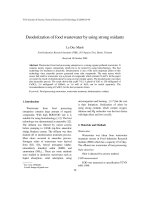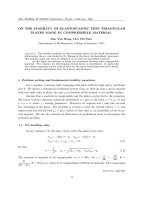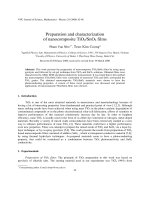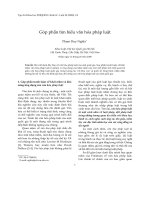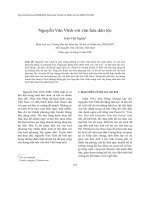Tài liệu Báo cáo " Checking the conformability in CORBA component model specifications " pdf
Bạn đang xem bản rút gọn của tài liệu. Xem và tải ngay bản đầy đủ của tài liệu tại đây (171.98 KB, 11 trang )
VNU Journal of Science, Natural Sciences and Technology 24 (2008) 92-102
92
Checking the conformability in CORBA component model
specifications
Tran Thi Mai Thuong
*
, Vo Van Thanh, Truong Ninh Thuan
College of Technology, VNU, 144 Xuan Thuy Road, Cau Giay District, Hanoi, Vietnam
Received 31 October 2007
Abstract. We proposed in this paper an approach for checking the conformability in CORBA
component model specifications. In software engineering, it is demonstrated that discovering bugs
in earlier phases is much more economical than later phases. We focused thus on verifying
components by their ports specification. In order to do this, firstly we determined constraints on
kinds of port as well as on types of port which the connection between ports must satisfy, and then
formalized them to be able to prove automatically using formal prover tools. Here, we proposed to
use the B method for verifying components in a CCM specification.
1. Introduction
*
The enormous expansion in the use of
software in every field of life make demands on
installing and developing reusable, robust,
reliable, flexible, adaptive software systems
much accelerating. As these demands are
growing stronger, the complexity of processes
that software manages is increasing along with
the demand for the integration of processes
from different areas. As a consequence,
software programs are becoming increasingly
large and complex. The appearance of
component based software engineering (CBSE)
adapts this challenge of the software
development; it proposes an easy and efficient
method for developing large software.
In this approach, the architecture of a
system is described as a collection of
_______
*
Corresponding author. E-mail:
components (reusable parts) along with the
interactions among those via their ports. The
main feature of CBSE is to allow the
construction of an application using
independently developed software components,
leading to reduce development costs and
improved software quality. In this process, it is
essential to ensure that individual components
can in fact interoperate together in the system.
However the components do not interact
seamlessly. Problems could arise in the system
if there are mismatches and inadequacies of
connected points between components. It is
important to verify the correctness of
component composition. In order to do it, there
are many approaches appeared to verify the
compatibility between components by
interfaces [1,2], behaviour specification [3],
models [4]
As we know, however, CBSE is also an
approach to develop software systems, hence
T.T.M. Thuong et al. / VNU Journal of Science, Natural Sciences and Technology 24 (2008) 92-102
93
discovering bugs in the earlier phases will
reduce much time and effort in building
software systems, especially large systems. So,
in this paper, we propose an approach to verify
the conformability between components
through specifications of their ports. This is a
buffer step before verifying behaviour
specifications of components, because it will
remove many unneccesary cases which are
inputs for checking behaviours.
Here, we use the CORBA Component
Model (CCM) ports. Firstly, CCM specification
of components is described by XML. We then
determine the conditions such that ports can be
connectable. From the XML desciption and
these constraints, we finally build a B abstract
machine which can be used to check the
consistency of connected ports in the model.
The B method [5] is used to verify the
compatibility between ports. Because, the B
notations are based on set theory, generalised
substitutions and first order logic, these are
easily to describe ports and their relation. In
addition, the proof obligations for B
specifications are generated automatically by
support tools like AtelierB [6], B-Toolkit [7]
and B4free [8]. Checking proof obligations with
B support tools is automatically perfomed.
In the following, we present an overview of
components specifying approaches. We then
describe our method in Section 3 and illustrate
it with the case study of the Stock Quoter
System. In Section 4, we discuss related work.
The paper finishes with some concluding
remarks in Section 5.
2. Specification of software components
Specification of software components is one
of the most important research challenges in
component-based software engineering. It
represents the first step towards true component
reuse as the component specification gives all
necessary information to the component user on
how/why the component can be (re) used.
A component is considered to be a black
box. Hence, interfaces are the only access
points to the component and the specification of
the component comes down to the specification
of the component interfaces.
Specification of the component interfaces in
the current component-based systems is done
by two levels:
• On the first level, syntactical level, there
are some specification models such as
JavaBeans [9], COM+ [10], CCM [11],
.NET [12], and the Open Service Gateway
Initiative (OSGI) [13]. At this level, The
component specification consists of
specification of provided and required
interfaces. Provided interfaces are the one
that contain operations that a component
provides to other components or to the
component user, while required interfaces
are the one that contain operations used by
the component.
• On the second level, semantic
specification, there are two representatives:
Unified Modeling Language (UML) and
the Object Constraint Language (OCL), in
which a component implements a set of
interfaces. Each interface consists of a set
of operations with associated pre and
postconditions, as well as component state
and invariants. Preconditions are assertions
that the component assumes to be fulfilled
before an operation is invoked, while
postconditions are assertions that the
component guarantees will hold just after
the operation has been invoked. An
invariant is a predicate over the interface’s
state that will always hold.
In this paper, we focus on verifying the
conformability between components by ports in
CCM (CORBA Component Models). The CCM
T.T.M. Thuong et al. / VNU Journal of Science, Natural Sciences and Technology 24 (2008) 92-102
94
is the most recent and complete component
specification from OMG [14]. It has been
designed on the basis of the accumulated
experience using CORBA service, JavaBeans,
and EJB. The major goal behind the CCM
specification is to provide solution to the
complexity reached by CORBA and its
services. One of the advantages of CCM is its
effort to integrate many of the facets involved
in software engineering. As a consequence, a
software application is described in different
formalisms along two dimensions: the time
dimension (the life cycle, from design to
deployment) and the abstract dimension (from
abstractions to implementation). Altogether,
this makes a rather complex specification.
CCM simply defines the concept of
connection as an object reference; thus CCM,
like all other industrial component models, does
not provide a connector concept. Nevertheless,
components are connected by linking facets to
receptacles and event sources to event sinks.
Connections are binaries and oriented, but the
same port can handle multiple connections.
Connections can be explicitly described (in the
assembly descriptor, an XML file) and
established by the CCM framework at
initialization.
Components support a variety of surface
features through which clients and other
elements of an application environment may
interact with a component. These surface
features are called ports. The component model
supports four basic kinds of ports [15] (see
Figure 1):
CORBA component interface Ports
Fig. 1. CORBA component interface and its ports.
• Facets, which are distinct named interfaces
provided by the component for client
interaction.
• Receptacles, which are named connection
points that describe the component’s ability
to use a reference supplied by some external
agent.
• Event sources, which are named connection
points that emit events of a specified type to
one or more interested event consumers, or
to an event channel.
• Event sinks, which are named connection
points into which events of a specified type
may be pushed.
Basic components are not allowed to offer
facets, receptacles, event sources and sinks.
They may only offer attributes. Extended
components may offer any type of port.
3. Case study: Stock Quoter System
To demonstrate our approach, we use a case
study of the Stock Quoter System
1
with two
components connected by their ports. However,
our approach will work with more complex
systems in which there are many connected
components. According to this approach, we
_______
1
Attribute
Event source
Event sink
Receptacle
Facet
T.T.M. Thuong et al. / VNU Journal of Science, Natural Sciences and Technology 24 (2008) 92-102
95
firstly transform CCM specification of
components into XML format. We then express
XML description and constraints which we
defined above as inputs of B abstract machine.
Finally, we use an automatic proof tool to check
the consistency of connected ports in the model
with B abstract machine.
Figure 2 illustrates the components in stock
quoter system example using the CORBA
Component Model (CCM). The
StockDistributor component monitors a real-
time stock database. When the values of
particular stocks change, it pushes a CCM
eventtype that contains the stock’s name via a
CCM event source to the corresponding CCM
event sink implemented by one or more
StockBroker components. If these components
are interested in the stock they can obtain more
information about it by invoking a
request/response operation via their CCM
receptacle on a CCM facet exported by the
StockDistributor component.
notification_rate
notifier_in
Stock notifier_out
Distributor Stock
quoter_info_out Broker
quoter_info_in
Fig. 2. CORBA component interface and its ports.
component StockBroker {
consumes StockName notifier_in;
uses StockQuoter quoter_info_in;
};
StockBroker contains two ports that
correspond to the following two roles it plays.
It’s a subscriber that consumes a
StockName eventtype called notifier_in that’s
published by the StockDistributor when the
value of a stock changes. As shown in Figure 2,
the notifier_in event sink will be connected to
the StockDistributor’s notifier_out event source
by the standard CCM deployment and
configuration tools when the application is
launched.
It uses the StockQuoter interface provided
by the StockDistributor component, which
reports additional information about a stock,
such as the high, low, and most recent trading
values of the stock during the day. The
dependency of StockBroker on StockQuoter is
indicated explicitly in IDL 3.x via the
quoter_info_in receptacle, which will be
connected to StockDistributor’s
quoter_info_out facade by the deployment and
configuration tools when the application is
launched.
We now present the implementation of the
StockDistributor component, whose ports are
shown here:
component StockDistributor
supports Trigger {
publishes StockName notifier_out;
provides StockQuoter
quoter_info_out;
attribute long notification_rate;
};
It publishes a StockName eventtype called
notifier_out that is pushed to the StockBroker
subscriber components when a stock value
T.T.M. Thuong et al. / VNU Journal of Science, Natural Sciences and Technology 24 (2008) 92-102
96
changes. In addition, it defines a StockQuoter
facet called quoter_info_out, which defines a
factory operation that returns object references
that StockBroker components can use to obtain
more information about a particular stock.
Finally, this component defines the
notification_rate attribute, which system
administrator applications can use to control the
rate at which the StockDistributor component
checks the stock quote database and pushes
changes to StockBroker subscribers.
We now consider the verification of
conformability between components when we
have information describing the connection
between ports of components from their CCM
specification in this system.
Recall that information in component
specification can be described by XML. XML
(Extensible Markup Language) [16] is a simple,
very flexible text format derived from SGML.
Originally designed to meet the challenges of
large scale electronic publishing, XML is also
playing an increasingly important role in the
exchange of a wide variety of data on the Web
and elsewhere.
XML can also use to define metamodel or
metadata of a system specification. With a
XML document described valid CORBA
system, it can provide an easy way to extract
information about components and its ports for
the verification purpose.
The ADL specification of the Stock Quoter
System presented in Figure 2 can be described
by XML as the following.
Note that, in a CCM specification, if a
receptacle’s uses declaration does not include
the optional multiple keyword, then only a
single connection to the receptacle may exist at
a given time. If a receptacle’s uses declaration
includes the optional multiple keyword, then
multiple connections to the receptacle may exist
simultaneously.
There are two categories of event sources,
emitters and publishers. Both are implemented
using event channels supplied by the container.
An emitter can be connected to at most one
proxy provider by the container. A publisher
can be connected through the channel to an
arbitrary number of consumers, who are said to
subscribe to the publisher event source. A
component may exhibit zero or more emitters
and publishers.
A publisher event source has the following
characteristics [11]:
• The equivalent operations for publishers
allow multiple subscribers (i.e., consumers)
to connect to the same source
simultaneously.
• Subscriptions to a publisher are delegated
to an event channel supplied by the
container at run time. The component is
guaranteed to be the only source publishing
to that event channel.
An emitter event source has the following
characteristics [11]:
• The equivalent operations for emitters allow
only one consumer to be connected to the
emitter at a time.
• The events pushed from an emitter are
delegated to an event channel supplied by the
container at run time. Other event sources,
however, may use the same channel.
As a consequence, CCM components can
be connected if their ports satisfy conditions:
PD1. Facet can connect only to receptacles
(provides port connect only to uses port)
PD2. Event source can connect only to event
sinks (We can say that publishes and emits
ports can connect only to consumes ports)
PD3. Each provides port (facet) can connect to
many uses ports (receptacles), each
publishes port can connect to many
consumes ports but not on the contrary.
T.T.M. Thuong et al. / VNU Journal of Science, Natural Sciences and Technology 24 (2008) 92-102
97
PD4. Each emits port connect only to one
consumes port.
PD5. With two connected ports, type of
provided ports (facets, event sources) is a
subtype of the one of required ports
(receptacles, event sinks).
3.1. Checking types of port in connections
Each component is described in a
component based model with two phases. The
first one is the type, represents the functional
interface of the component, what is visible by
other components. The second one is the
implementation, describes the contents of the
component.
The aim of separation of a component
description into a type and an implementation is
the point of view of the component. Describing
the type means specifying the component
interface, expressing how it is seen from an
external point of view. On the other hand, the
implementation represents the interior. In
practice, the description of the type and the
implementation may be done by different
persons, each of them dealing with one step in
the refinement of the architecture description,
from the top level to the detail level.
An inheritance mechanism exists to
describe the components. It may be used for
both the types and the implementations. This
mechanism is useful to refine a description by
overwritting an already existing component.
Restrictions exist, which must be respected.
Thus, a component type may inherit from
another component type of the same category.
In the same way, a component implementation
may inherit from another component
implementation of the same category.
The final condition of the compatibility
between ports (PD5) states that, type of
provided ports is a subtype of the one of
required ports. A verification shound be
considered to ensure the conformity between
the types and directions of the connected ports.
In order to verify conditions for connecting
ports in a CCM specification, we propose to use
the B method [5].
From the inheritance relationship between
types of ports, we create a simple B abstract
machine called Types machine (Figure 3). In
this machine, if an interface TYPE1 inherits
from an interface TYPE2, we define TYPE1 is
subtype of the TYPE2 (TYPE1 ⊆ TYPE2).
MACHINE Types
CONSTANTS
TYPE1, TYPE2, TYPE3
PROPERTIES
TYPE1
⊆
TYPE2; TYPE3
⊆
TYPE2
END
Fig. 3. Types abstract machine.
T.T.M. Thuong et al. / VNU Journal of Science, Natural Sciences and Technology 24 (2008) 92-102
98
From the Types machine, if we want to
check the consistency of the type between two
ports in a connection, we have to get the type of
required port (TYPE1) and the type of provided
port (TYPE2). Each time we get a connection,
we have to give a fragment specification as the
following into the B specification, according to
the definition of subtype:
ANY conn WHERE
conn
∈
TYPE2
THEN
conn :
∈
TYPE1
END
The B prover will check if TYPE2 is a
subtype of TYPE1 from this specification.
3.2. Checking kinds of port in connections
The B machine that we build to verify the
correctness of the ADL Acme specification [17]
is called the ConnectionCheck. From the XML
description, we can get all ports and the kind of
port (uses port, provides port, consumes
ports ) in the specification. They are presented
in the SETS clause of the machine.
We declare the variables connectionU_P to
contain and check the connection between uses
ports and provides ports, connectionC_P to
contain the connection between consumes ports
and publishes ports, connectionC_E to contain
the connection between consumes ports and
emits ports. These variables have to satisfy four
conditions (PD1, PD2, PD3, PD4) described in
the above. These constraints can be formally
described in the INVARIANTS clause as the
following:
connectionU_P
∈
USESPORT 7→PROVIDESPORT^
connectionC_E
∈
CONSUMESPORT→EMITSPORT^
connectionC_P
∈
CONSUMESPORT7→PUBLISHESPORT
In these constraints, type of these three
variable define the type of a possible
connections in the specification.
We use the partial function ( ) to denote
the relation between the domain and the range
of the connection between uses port and
provides ports; consumes port and publishes
port. It means that, one element of the domain
cannot connect to have more than one element
of the range and one element of the range can
connect to many elements of the domain
(Figure 4). We use the partial bijection ( ) to
denote the relation between consumes port and
emits port. It means that each element of the
domain can connect only to one element of the
range.
Y
X
a
1
2 d
3 b
4 c
Fig. 4. Relations in a partial function.
T.T.M. Thuong et al. / VNU Journal of Science, Natural Sciences and Technology 24 (2008) 92-102
99
In the OPERATIONS clause of the
machine, we define operations for extracting all
connections in the CCM specification. In these
operations, we intergrate the fragment
specification of checking types between ports of
the connection. The machine presented in
Figure 5 illustrates the B notations of the
verification purpose for the case study of the
Stock Quoter System in Figure 2. It is to be
noted that, all information in this abstract
machine can be extracted from the XML
description hence it can be built automatically.
4. Related work
Several proposals for verifying the
interoperability between components have been
made.
The paper [4] present a tool called Cadena,
an integrated environment for building and
modeling CCM systems. Cadena provides
facilities for defining component types using
CCM IDL, specifying dependency information
and transition system semantics for these types,
assembling systems from CCM components,
visualizing various dependence relationships
between components, specifying and verifying
correctness properties of models of CCM
systems derived from CCM IDL, component
assembly information, and Cadena
specifications, and producing CORBA stubs
and skeletons implemented in Java.
As a point of comparison, this paper
generated a DSpin model for the scenario that
check the number of timeouts issued in a
system execution.
Zaremski and Wing [18] propose an
approach to compare two software components.
They determine whether one required
component can be substituted by another one.
They use formal specifications to model the
behavior of components and exploit the Larch
prover to verify the specification matching of
components
MACHINE ConnectionCheck
SEES Types
SETS
USESPORT = {quoter_info_in};
PROVIDESPORT = {quoter_info_out};
CONSUMESPORT = {notifier_in};
PUBLISHESPORTS = {notifier_out}; EMITSPORTS;
VARIABLES
connectionU_P, connectionC_P, connectionC_E
INVARIANTS
ConnectionU_P ∈
USESPORT →PROVIDESPORT ∧
ConnectionC_P ∈
CONSUMESPORT →PUBLISHESPORT ∧
ConnectionC_E ∈
CONSUMESPORT → EMITSPORT
INITIALISATION
ConnectionU_P := ∅ ||
connectionC_P := ∅ || connectionC_E := ∅
OPERATIONS
GetConnectionU_P =
PRE
ConnectionU_P USESPORT →PROVIDESPORT
T.T.M. Thuong et al. / VNU Journal of Science, Natural Sciences and Technology 24 (2008) 92-102
100
THEN
ConnectionU_P :=
connectionU_P ∪{notifier_in →notifier_out} ||
ANY conn WHERE /* Check type of ports */
conn STOCKNAME /* type of provides port */
THEN
conn : ∈ STOCKNAME /* type of uses port */
END
END;
getConnectionC_P =
PRE
connectionC_P ∈
CONSUMESPORT →PUBLISHESPORT
THEN
connectionC_P := connectionC_P ∪
{quoter_info_in →quoter_info_out} ||
ANY conn WHERE /* Check type of ports */
conn ∈ STOCKQUOTER /* type of publishes port */
THEN
conn : ∈ STOCKQUOTER /* type of consumes port */
END
END;
getConnectionC_E =
PRE
connectionC_E ∈ CONSUMESPORT → EMITSPORT
THEN
connectionC_E := connectionC_E ∪ ∅…
END
END
Fig. 5. B abstract machine for verifying compatibility between component ports.
In [1,2], protocols are specified using a
temporal logic based approach, which leads to a
rich specification for component interfaces.
Henzinger and Alfaro [19] propose an approach
allowing the verification of interfaces
interoperability based on automata and game
theories: this approach is well suited for
checking the interface compatibility at the
protocol level.
The paper [3] proposes the Port State
Machine (PoSM) to model the communication
on a Port. Building on their experience with
behavior protocols, they model an operation
call as two atomic events request and response,
permitting PoSM to capture the interleaving
and nesting of operation calls on provided and
required interfaces of the Port. The trace
semantics of PoSM yields a regular language.
They apply the compliance relation of behavior
protocols to PoSMs, allowing to reason on
behavior compliance of components in software
architectures.
Our work focuses on the verification of
interoperability of specification of components
through their ports. We determine the
conditions for the connection between ports and
use the B method for verifying their
compatibility.
T.T.M. Thuong et al. / VNU Journal of Science, Natural Sciences and Technology 24 (2008) 92-102
101
5. Conclusion
We have presented some aspects of
component specifications, outlined our
approach of components vefification based on
kinds of connectable ports, through proving the
correctness of their CCM specification using B
method. Concurrently, we also described more
detail the transformation from ports’ informal
connection constraints to formal formats to be
able to input into B machine for verifying. We
have presented a small but illustrative case
study, showing in particular kinds of ports
which can be connectable as well as the activity
machenism of B machine in proving the
soundness of CCM specification.
In previous work, we defined constraints on
ports, and thanks to these we can know which
components can connect together properly if
their ports satisfy requirements which we given.
At this degree, we have just only known kinds
of port (facet, receptacle, event source, event
sink) and only verified constraints on these
kinds of port. In this paper, we contributed to
verifying connection conditions on types of port
and integrating it into kinds of port to assist our
approach. This will support us much on
verifying the compatability between
components by behaviour specification at
semantic level.
In the future work, we will carry out to
check the composition between behaviors of
ports when connection between types of port is
correct. Since then, we will build a framework
supporting the process of installing, verifying
and developing component-based systems. This
leaves the opportunity for the designer to use
the tool best suited to the problem, and to
perform formal analysis on parts of the system
that particularly deserve it.
Acknowlegments. This work is partly
supported by the research project No. QC.07.04
granted by Vietnam National University, Hanoi.
References
[1] J. Han, “A comprehensive interface definition
framework for software components”, In Asia Pacific
software engineering conference, IEEE Computer
Society (1998) 110.
[2] J. Han, Temporal logic based specification of
component interaction protocols, In Proceedings of
the Second Workshop on Object Interoperability
ECOOP’2000, Springer-Verlag, (2000) 12.
[3] V. Mencl, “Specifying component behavior with port
state machines”, Electronic Notes in Theoretical
Computer Science, Special issue: Proceedings of the
Workshop on the Compositional Verification of UML
Models, 101C:129, 2004.
[4] J. H. et al. “Cadena: an integrated development,
analysis, and verification environment for
component-based systems”, In Proceedings of 25th
International Conference on Software Engineering,
(2003) 160.
[5] J.R. Abrial, The B-Book, Assigning Programs to
Meanings, Cambridge University Press, 1996.
[6] Steria, Obligations de preuve: Manuel de ref´erence´.
Steria - Technologies de l’information, version 3.0,
Available at .
[7] B.C. Ltd. B-Toolkit User’s Manual, Oxford (UK),
1996, Release 3.2.
[8] Clearsy, B4free. Available at ,
2004.
[9] Sun Microsystems, JavaBeans 1.01 Specification,
[10] G. Eddon, H. Eddon, Inside COM+ Base Services.
Microsoft Press, 2000.
[11] CORBA Component Model Specification, Version
4.0,
[12] Microsoft, .NET,
[13] OSGI, OSGI Service Gateway Specification, Release
1.0, .
[14] .
[15] I. Crnkovic, M. Larsson. “Building reliable
componentbased Software Systems”, Artech House,
Inc, 2002.
[16] World Wide Web Consortium, XML,
[17] Nguyen Hoang Ha, Tran Thi Mai Thuong, Truong
Ninh Thuan, Nguyen Viet Ha, “Verifying the
compatibility of components’ ports upon
specification”, In Japan Vietnam Workshop on
Software Engineering 2007, September 2007.
[18] A. M. Zaremski, J. M. Wing, “Specification matching
of software components” 6(4) (1997) 333.
[19] L. Alfaro, T.A. Henzinger, “Interface automata”, In
9th Annual Symposium on Foundations of Software
Engineering, ACM press, (2001) 109.
T.T.M. Thuong et al. / VNU Journal of Science, Natural Sciences and Technology 24 (2008) 92-102
102
ANNEX - XML specification for CMM Stock Quoter System.
<connections>
<?xml version="1.0" encoding="UTF-8"?> <Model>
<connectinterface> <usesport>
<usesidentifier>quoter_info_in</usesidentifier> <type>StockQuoter</type>
<componentinstantiationref idref="StockBroker"/>
</usesport> <providesport>
<providesidentifier>quoter_info_out</providesidentifier>
<type>StockQuoter</type> <componentinstantiationref
idref="StockDistributor"/>
</providesport> </connectinterface> <connectevent>
<consumesport> <consumesidentifier>notifier_in</consumesidentifier>
<type>StockName</type> <componentinstantiationref idref="StockBroker"/>
</consumesport> <publishesport>
<publishesidentifier>notifier_out</publishesidentifier>
<type>StockName</type> <componentinstantiationref
idref="StockDistributor"/>
</publishesport> </connectevent>
</Model>
</connections>




